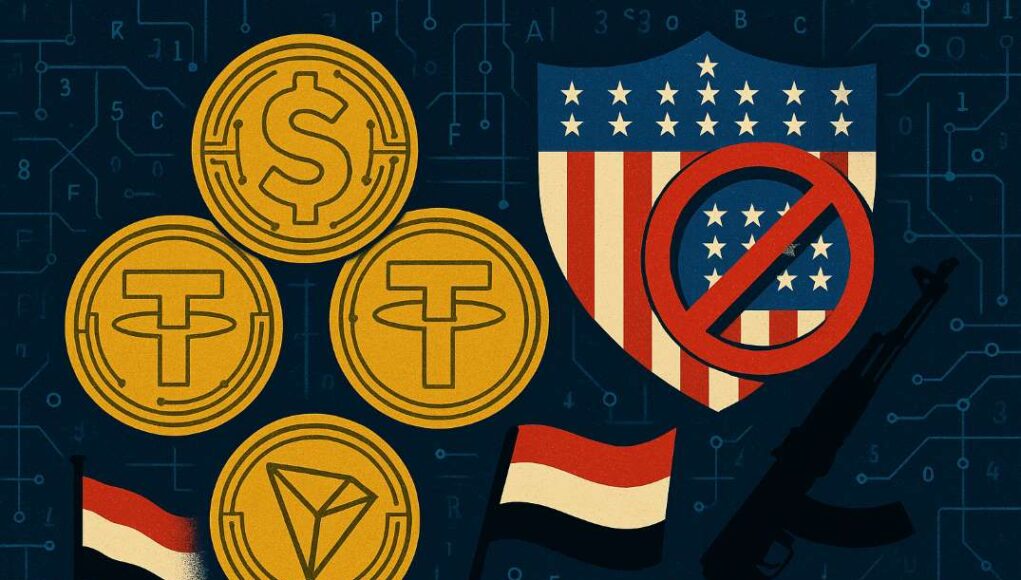The U.S. Treasury has blacklisted eight cryptocurrency wallets allegedly tied to Yemen’s Houthi rebels and the Russia-based sanctioned crypto exchange Garantex. This marks a new chapter in using digital assets for geopolitical destabilization, with nearly $1 billion in USDT transacted across Tron-based wallets. The case underscores how stablecoins are becoming the preferred tool for sanctioned entities to move funds beyond the reach of traditional financial systems.
Crypto-Backed Sanctions Evasion: The Treasury’s Findings
The U.S. Department of the Treasury’s Office of Foreign Assets Control (OFAC) sanctioned eight wallets allegedly linked to Houthi operatives and Garantex. OFAC stated they were used to launder significant volumes of stablecoins. All eight wallets operated on the Tron blockchain and were transacting in Tether (USDT).
Two addresses were reportedly tied to centralized exchanges. The other six wallets were controlled by individuals or entities facilitating peer-to-peer transactions. According to the Treasury, the wallets were involved in procurement networks acquiring weapons and dual-use goods. Iranian and Russian intermediaries allegedly played a key role.
“Houthi financial facilitators have used a complex network of exchange houses and money launderers, including individuals located in Iran, Djibouti, and Turkey, to collect funds and to funnel the group’s financial activity through a global web of exchange operators,” the Treasury said in its April 4 statement.
Tron and Tether: Tools for Terror?
The transactions occurred exclusively in USDT on Tron. Such a pattern is frequently observed in illicit activity due to Tron’s low transaction costs and speed. According to Chainalysis, a blockchain analytics firm, most of the illicit wallet activity happened after Garantex was initially sanctioned in 2022. That raises questions about the effectiveness of sanctions enforcement in the decentralized finance ecosystem.
Garantex, a Russian crypto exchange already blacklisted for facilitating ransomware and darknet activity, was again linked to this laundering network. The Treasury’s findings suggest that the Houthis leveraged Garantex and affiliated intermediaries to convert crypto into tangible assets, including weapons and equipment.
A Growing Role for Stablecoins in Illicit Finance
This enforcement action highlights a growing trend: stablecoins are emerging as a favored vehicle for sanctioned actors. Unlike Bitcoin, which is volatile, stablecoins like USDT offer price stability and dollar exposure. Stablecoins are ideal tools for operational spending by groups operating outside the formal banking system.
The Houthis themselves have previously acknowledged using crypto as a workaround for banking restrictions and sanctions. In a now-deleted Telegram post, a Houthi spokesperson described digital assets as “a necessary alternative” in light of international financial blockades.
Industry Implications: Pressure Mounts on Infrastructure Providers
The case raises serious questions about crypto infrastructure’s role in enabling illicit finance. Neither Tether nor Tron are accused of wrongdoing. Nevertheless, their networks were used to facilitate nearly $1 billion in illicit transfers.
Tether Ltd. froze wallets in previous law enforcement cases and claims to work closely with authorities. But, these actions are typically reactive rather than proactive. The incident renews scrutiny of the need for real-time monitoring tools and deeper wallet-level due diligence. That holds particularly true for platforms facilitating off-ramp transactions or host wallet infrastructure.
A Policy Turning Point for Crypto and National Security
The OFAC sanctions mark a turning point in how the U.S. treats stablecoins, as financial products, and as potential instruments of national security risk. They also reflect a broader trend in global regulation, where digital asset compliance standards are increasingly tied to counterterrorism and anti-money laundering frameworks.
With U.S. lawmakers and regulators already weighing stricter controls on stablecoin issuance, this case could accelerate the legislative push toward requiring stablecoin issuers and blockchain platforms to enforce KYC, wallet tracking, and counterparty risk controls.
>>> Read more: Russia’s Crypto Loophole: Can Sanctions Stop Oil Trade?
Conclusion: The Double-Edged Sword of Blockchain Technology
The Houthis–Garantex case demonstrates the strengths and vulnerabilities of blockchain-based finance. While blockchain offers transparency and traceability, bad actors are exploiting the speed and pseudonymity of decentralized networks to circumvent global sanctions regimes. For policymakers, this incident is a warning shot. Stablecoins are no longer a theoretical risk vector but a present and operational one.
Readers’ frequently asked questions
If Tether and Tron weren’t directly involved in any wrongdoing, why are they mentioned so often in connection with illicit activity?
Tether and Tron weren’t implicated as bad actors, but their technologies were used in the transactions now under sanction. That’s because USDT, Tether’s dollar-pegged stablecoin, and the Tron blockchain are popular for very legitimate reasons. USDT is widely accepted and holds its value. Tron is fast and cheap to use. However, these same features also make them attractive to people trying to move money discreetly or cheaply. And that includes those engaged in illegal activities. That doesn’t make Tether or Tron guilty, but it does put their infrastructure under more scrutiny. Regulators are increasingly questioning whether platforms and issuers like these should do more to monitor the use of their services, even if they aren’t directly responsible for the wallets involved.
How does the U.S. government enforce sanctions on crypto wallets if the blockchain is supposed to be decentralized?
Enforcing sanctions in a decentralized system is tricky, but not impossible. When the U.S. sanctions a crypto wallet, it adds the wallet’s address to the Specially Designated Nationals (SDN) list. From that point on, U.S.-based companies, crypto exchanges included, may not legally interact with those wallets. Major exchanges and financial service providers must block transactions with those addresses. In addition, some stablecoin issuers like Tether can technically freeze tokens held in blacklisted wallets if requested by law enforcement. So while the government cannot shut down the blockchain itself, it can heavily restrict access to the real-world services that make crypto useful, such as exchanges and stablecoins.
What should regular crypto users or investors take away from this? Could this kind of enforcement affect them?
Most everyday crypto users won’t be directly affected by these sanctions if they’re using legitimate platforms and not transacting with wallets on the sanctions list. However, these actions highlight a growing trend: governments are no longer just watching crypto; they’re acting on it. This means compliance is becoming a bigger part of the crypto landscape. If you’re an investor, it’s worth being aware that regulatory actions could impact stablecoins and exchanges you rely on if they’re found to be tied to illicit flows. Over time, users may see more identity checks, more frozen wallets, and tighter restrictions, even for innocent users, especially on platforms with global reach. Staying on regulated exchanges and being aware of where your funds go is becoming increasingly important
What Is In It For You? Action Items You Might Want to Consider
Reevaluate your exposure to USDT on the Tron network
Given that USDT on Tron was the preferred vehicle for nearly $1 billion in illicit flows, it’s safe to say this pairing has drawn regulatory heat. While it’s still widely used, traders should consider diversifying across other chains or stablecoins (like USDC on Ethereum or Arbitrum) that may carry less risk of scrutiny or disruption going forward.
Double-check your counterparties and wallet connections
It’s no longer enough to avoid darknet markets or obvious scam projects. Regulatory bodies are tracking wallet flows more aggressively, and transacting (unknowingly or not) with sanctioned addresses could put your funds or access at risk. Consider using wallet screening tools or services with built-in compliance alerts to stay on the safe side.
Stay ahead of enforcement by favoring KYC-compliant platforms
While some traders prefer non-custodial and offshore platforms, the regulatory tide is turning fast. The safest move may be to stick with exchanges that enforce KYC and AML procedures. These platforms are more likely to survive in a tightening regulatory environment. They also reduce your exposure to reputational or transactional fallout.











[…] >>> Read more: Crypto Sanctions: U.S. Targets Houthi Wallets […]